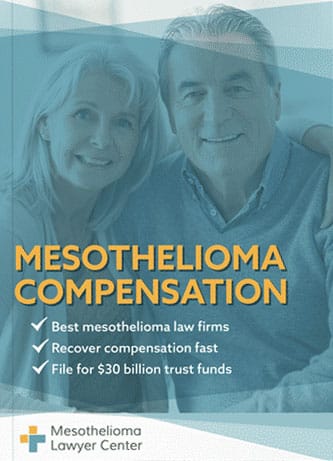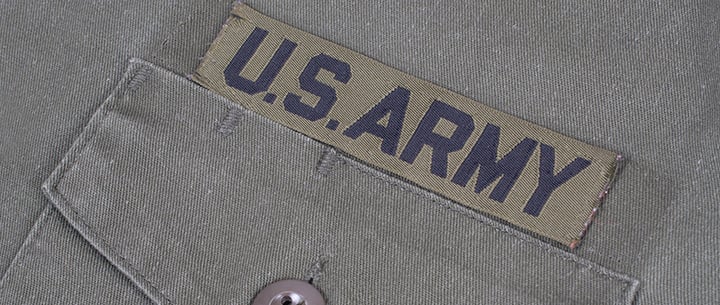U.S. Army veterans are at an increased risk for mesothelioma and other asbestos illnesses. The Army used asbestos in bases, housing, vehicles, equipment, and more. Veterans with mesothelioma are eligible for benefits and compensation.
If you or a loved one were diagnosed with mesothelioma, asbestos-related lung cancer, or asbestosis, you might be entitled to substantial compensation. Fill out our form to receive our free Financial Compensation Packet. Our packet is loaded with information on experienced mesothelioma attorneys in your area, how to file a claim for asbestos trust funds, how to get paid in 90 days, and more.


FREE Financial Compensation Packet
- Info on law firms that will recover your HIGHEST COMPENSATION
- Learn how to get paid in 90 days
- File for your share of $30 billion in trust funds

Why Army Veterans Are at Risk for Mesothelioma
Mesothelioma is a rare cancer known to be caused by asbestos exposure. Approximately 3,000 people are diagnosed with mesothelioma in the U.S. every year. Nearly 30% of mesothelioma diagnoses are in veterans of any branch of the military.
The connection between high rates of mesothelioma in veterans and asbestos use in the military is clear. Many veterans who served in the Army between the 1930s and the end of the Vietnam War were exposed to asbestos.
Are Army Veterans at Risk for Other Asbestos Illnesses?
Even with high rates of exposure, mesothelioma is a rare diagnosis. Most veterans exposed to asbestos will never have mesothelioma, but they can develop other more common illnesses:
- Lung cancer
- Other cancers
- Asbestosis
- Pleural plaques
- Pleural thickening
Which Veterans Are Most at Risk for Mesothelioma?
No amount of asbestos exposure is safe, but anyone exposed to asbestos once or twice is unlikely to develop mesothelioma. The Army veterans at greatest risk for mesothelioma were repeatedly exposed to asbestos through their jobs.
Asbestos was most heavily used in construction materials, vehicles, and equipment. Veterans in the following roles have a higher risk of mesothelioma:
- Construction
- Carpentry
- Demolition
- Insulation repair or installation
- Pipefitting
- Plumbing
- Boiler work
- Mechanical and vehicle repair and maintenance
Family members of men and women who worked around asbestos in the Army are also at risk for mesothelioma. Secondhand exposure occurred when workers brought fibers of asbestos home on their clothing, exposing family members. Some of these family members develop asbestos illnesses later.
Benefits for Army Veterans With Mesothelioma
Members of the U.S. Army should have been protected from asbestos exposure. Those who develop related illnesses later are entitled to certain benefits from the U.S. Department of Veterans Affairs (VA).
Compensation for Veterans With Asbestos Illnesses
One of the most important types of benefits for veterans with mesothelioma is compensation. Mesothelioma and other asbestos illnesses are debilitating. Most people with these illnesses cannot work. They also face treatment costs, travel for care, and home care.
The VA offers two main types of compensation benefits for Army veterans with mesothelioma:
- Disability compensation provides veterans with a monthly payment for being disabled.
- Special monthly compensation is available to some veterans who need care in their homes. It is extra compensation in addition to regular monthly disability payments.
Compensation for Family of Veterans Affected by Asbestos
The VA also offers compensation for spouses, dependent children, and sometimes parents of veterans with mesothelioma. This is part of the monthly disability compensation, which increases for each additional dependent of the veteran.
Families can also receive compensation when a veteran dies from an asbestos illness:
- Dependency and indemnity compensation is a benefit offered to qualifying surviving spouses and children of veterans.
- Funeral expenses cover some or all of the burial and funeral costs for a deceased veteran.
Additional VA Benefits for Veterans
Beyond financial compensation, the VA provides a variety of benefits to support veterans in multiple aspects of life. Veterans may qualify for housing grants, which can assist in acquiring or adapting homes to meet their specific needs.
Life insurance options are available, offering peace of mind for veterans and their families. Access to health benefits ensures veterans receive necessary medical care, particularly critical for those with service-related conditions.
For veterans exposed to asbestos and suffering from related diseases, the VA offers specialized treatment at medical centers staffed with doctors experienced in diseases like mesothelioma. This healthcare support is crucial given the historical use of asbestos in military environments.
These offerings highlight the VA’s commitment to addressing the diverse needs of veterans, ensuring they receive both financial and non-financial support throughout their lives.
How Much Disability Compensation Can Army Veterans Get?
The amount of compensation veterans receive depends on their disability rating and number of dependents. The VA gives mesothelioma and lung cancer caused by asbestos a disability rating of 100%. These veterans are entitled to full disability compensation.
The VA rates other asbestos illnesses between 10% and 100%, depending on individual factors. These veterans receive a percentage of the total amount.
As of 2023, the monthly disability compensation for a veteran with a 100% rating and no spouse, children, or qualifying parents is $3,621.95.
Healthcare Benefits for Veterans with Mesothelioma
Veterans with mesothelioma and other asbestos illnesses can receive free or low-cost medical care at VA medical centers and hospitals. Because veterans are at such high risk for mesothelioma, several VA facilties offer treatment and staff specialists:
- Michael E. DeBakey VA Medical Center, Houston, TX
- VA Boston Healthcare System, Boston, MA
- VA Greater Los Angeles Healthcare System, Los Angeles, CA
- Miami VA Healthcare System, Miami, FL
Understanding the Veterans Community Care Program (VCCP)
The Veterans Community Care Program (VCCP) is a crucial resource designed to support Army veterans, especially those dealing with health issues like asbestos-related diseases. It’s a revamped initiative, stemming from the former Veterans Choice Program, aiming to enhance healthcare access for veterans.
Key Benefits of the VCCP
- Access to Local Healthcare: One of the standout features of the VCCP is its provision for veterans to receive medical care at non-VA facilities closer to their homes. This is particularly beneficial for veterans suffering from asbestos-related diseases who might not live near a VA medical center.
- Improved Convenience: For Army veterans dealing with mobility issues or who are in need of urgent and frequent care, traveling long distances to access VA facilities can be burdensome. The VCCP alleviates this by allowing care at more conveniently located community providers.
- Eligibility Criteria: While specific eligibility criteria must be met to participate, these details are readily accessible on the official VA website, ensuring veterans can easily determine their qualification for this program.
By enhancing accessibility and convenience, the Veterans Community Care Program ensures Army veterans receive the timely and effective healthcare they need, right within their communities.
Treatment Options for Army Veterans with Mesothelioma
Army veterans diagnosed with mesothelioma have a range of treatment options available to them. The pathway to effective care often begins with understanding the resources provided by the VA and nearby specialized medical facilities.
VA’s Community Care Network
One of the primary avenues for treatment is the VA’s Community Care Network (CCN). This program enables veterans to access experienced mesothelioma specialists locally, ensuring they receive care without the need to travel extensively. The CCN is designed to provide flexibility and convenience, empowering veterans to seek expert medical help close to home.
VA Healthcare System
Apart from the CCN, veterans can also explore treatment options within the VA healthcare system itself. The system offers a variety of services tailored to meet the needs of those affected by asbestos-related conditions. Veterans may benefit from the comprehensive medical care provided by VA hospitals and clinics, where they can receive treatments spanning from surgery to chemotherapy and other advanced options.
Specialized Mesothelioma Centers Near Army Bases
Several centers are strategically located near large Army bases, offering veterans the possibility to access top-tier cancer treatment facilities. Some renowned centers include:
- UNC Lineberger Comprehensive Cancer Center: Known for its cutting-edge research and treatment options.
- Baylor Scott & White Clinic – Temple: Provides a range of treatments backed by specialists in cancer care.
- Swedish Cancer Institute at Swedish Medical Center: Offers innovative therapies and supportive care services.
Finding a Mesothelioma Center
Veterans should take proactive steps to find a suitable mesothelioma center that aligns with their healthcare needs. Locating a center involves assessing treatment options, evaluating proximity to home, and considering the expertise of the medical team. Such centers often provide personalized care plans geared towards improving quality of life and extending survival.
By leveraging these resources, Army veterans can access the necessary medical attention to manage mesothelioma, supported by a network designed to cater to their unique needs.
How to File a Claim for VA Benefits
If you are a veteran diagnosed with an asbestos illness, you have a right to seek benefits. To get those benefits, you must file a claim.
How Do I Qualify for VA Benefits?
The VA has two eligibility requirements for Army veterans to receive asbestos-related disability benefits:
- The veteran’s illness is related to asbestos exposure.
- The veteran was exposed to asbestos during military service.
How Do I Prove Asbestos Exposure in the Army?
When you file a claim with the VA for benefits, the burden is on you as the veteran to prove you are eligible. You must submit three things:
- Military service records that show you performed a role in the Army that likely exposed you to asbestos
- Medical records proving you were diagnosed with mesothelioma or another illness
- A doctor’s statement demonstrating that your diagnosis is related to asbestos exposure
Who Can Help Me File a VA Benefits Claim?
Anyone can help you file a claim for VA benefits. The process can be confusing, so relying on a professional with experience is best. Two good options include:
- An official Veterans Service Organization representative
- An experienced asbestos lawyer
Can Veterans Sue the Army for Asbestos Exposure?
Army veterans cannot sue the military or federal government for asbestos exposure and resulting illnesses. The VA provides benefits, including compensation, to make up for this.
Veterans can sue asbestos companies that supplied the Army with asbestos-containing materials. Asbestos companies that went bankrupt cannot be sued, but they set up asbestos trust funds to compensate claimants.
An experienced asbestos law firm or mesothelioma lawyer can help veterans with either of these options. They can help them sue asbestos companies or make a claim for compensation through a trust. These alternative sources of compensation do not disqualify a veteran or reduce the amount of their VA benefits.
How Did the Army Use Asbestos?
As with all other military branches, however, the Army’s heavy reliance on asbestos resulted in a multitude of soldiers developing life-threatening diseases such as mesothelioma and asbestosis.
The Army first used asbestos in the 1800s. The mineral, now classified as toxic to humans, was mixed with rubber to make gaskets and other parts for steam engines.
Steam engines were used in railroad trains that could quickly haul thousands of men across long distances. They were also used in steamboats, cargo ships, and other seagoing vessels that could carry American soldiers and their equipment to U.S. waterways or battlefields overseas.
Asbestos in Bases, Housing, and Other Buildings
Like the civilian construction industry, the Army also used asbestos as insulation to protect its facilities from fire or excessively high temperatures.
Military bases and their various supporting facilities were built with asbestos-containing materials. Every building in an Army base built from the early 1900s to the 1980s included flooring, wiring, insulation, drywall, and roofing material that contained asbestos.
Some of the Army bases known to have used asbestos include:
- Blue Grass Army Depot, KY
- Camp Blanding, FL
- Camp San Luis Obispo, CA
- Fort Benning, GA
- Fort Bragg, NC
- Fort Campbell, TN
- Fort Collins, CO
- Fort Dix, NJ
- Fort Hood, TX
- Fort Jackson, SC
- Fort Lee, VA
- Fort Lewis, WA
- Fort Monmouth, NJ
- Fort Shafter, HI
- New Cumberland Army Depot, PA
- Rock Island Arsenal, IL
Asbestos in Vehicles and Equipment
As the Army became more mechanized during the 20th Century, asbestos was mixed liberally with rubber and other materials to manufacture various mechanical parts and equipment. This was done to protect vehicles and facilities from heat damage caused by friction.
Army motor pools and train depots carried huge stocks of brake pads, gaskets, and clutches made with asbestos-containing materials. This exposed many mechanics to asbestos while performing routine maintenance on Army vehicles, especially during World War II.
Asbestos in Protective Gear and Clothing
The Army exploited the minerals’ innate flexibility and wove asbestos fibers into soldiers’ protective gear. During World War I and the following years, U.S. Army gas masks contained filters made with asbestos fibers.
Intended as a safety feature to protect soldiers from breathing deadly chlorine gases, these filters made it easy for asbestos to enter their respiratory systems.
The Army also wove asbestos fibers into certain types of clothing, particularly in jackets, gloves, and trousers used by firefighters on Army bases and auxiliary facilities.
During World War II, asbestos could be found in nearly everything the Army used. Parachute flares, rockets for bazookas, parts for Sherman tanks and Willys jeeps, wiring in B-17 bombers, and field dressings used by battlefield medics contained asbestos.
Is Asbestos Exposure Still a Risk in the Army Today?
Asbestos continues to be a risk in the Army and other branches of the military. It was used so extensively in the past that it has been impossible to completely eradicate asbestos, especially in buildings on bases.
In 2020, a Department of Defense report detailed asbestos issues at several military installations, including two in the Army. Several of the installations lacked accurate records of where asbestos was located. They also failed to notify service members and their families of asbestos risks in housing.
These issues are despite the Army’s Installation Asbestos Management Program. Implemented in the 1990s, the program is supposed to protect soldiers and their families from asbestos.
“The program is supposed to follow state and federal laws regarding asbestos safety. It also outlines guidelines for managing asbestos as it is identified on bases and in buildings. The program has led to numerous asbestos abatement projects.”
The Army’s Installation Asbestos Management Program, initiated in the late 1990s, plays a crucial role in safeguarding soldiers and workers from asbestos exposure. It mandates Army facilities both in the U.S. and overseas to:
- Comply with stringent asbestos regulations at both state and federal levels.
- Develop and implement asbestos management plans to address identified asbestos swiftly and safely.
This comprehensive approach not only ensures adherence to legal standards but also proactively manages asbestos risks. As a result, many bases have undertaken significant asbestos abatement projects, replacing the hazardous mineral with safer alternatives as recommended by the program. This ongoing effort reflects the Army’s commitment to maintaining a safe environment for its personnel.
The Hidden Dangers of Asbestos
After World War II, the War Department and the Department of the Army continued using asbestos. The asbestos manufacturers suppressed data demonstrating a link between asbestos and its health dangers.
Well-connected companies such as W.R. Grace and Johns-Manville ensured that information gathered by doctors as early as the 1890s remained out of the public eye.
The federal government kept purchasing and utilizing it in substantial quantities because asbestos was a safe and necessary material.
Researchers at the Environmental Protection Agency (EPA) carried out numerous studies that officially linked asbestos to three debilitating and fatal illnesses: asbestosis, asbestos-related lung cancer, and mesothelioma cancer.
Asbestos-related illnesses had been recorded much earlier, however. As early as Roman times, chronicles described cancer-like diseases that affected workers who had mined or processed asbestos. But, these accounts were not widely known.
When asbestos was first used on a massive industrial scale, the miners and distributors marketed the fibrous minerals as beneficial and healthy.
Eventually, medical studies in Great Britain and other asbestos-using countries established a causal link between the previously beneficial minerals, cancer, and asbestosis.
As a result of the EPA’s research on the growing number of mesothelioma cases, the U.S. government, including the Department of the Army, finally stopped purchasing asbestos.
Help for Army Mesothelioma and Asbestos Victims
If you’ve been injured by mesothelioma, asbestos-related lung cancer, or asbestosis, keep in mind that there is a good chance that you’ll qualify for considerable compensation. Remember to fill out our form to get your free Financial Compensation Packet, with information on experienced asbestos and mesothelioma lawyers in your area. If you have questions or need additional assistance, contact us at 800-793-4540.

Paul Danziger
Reviewer and EditorPaul Danziger grew up in Houston, Texas and earned a law degree from Northwestern University School of Law in Chicago. For over 25 years years he has focused on representing mesothelioma cancer victims and others hurt by asbestos exposure. Paul and his law firm have represented thousands of people diagnosed with mesothelioma, asbestosis, and lung cancer, recovering significant compensation for injured clients. Every client is extremely important to Paul and he will take every call from clients who want to speak with him. Paul and his law firm handle mesothelioma cases throughout the United States.
References
- Alleman, J.E. and Mossman, B.T. (1997, July). Asbesto Revisited. Scientific American.
Retrieved from: http://www.physics.smu.edu/pseudo/asbestosrevisited.pdf - Occcupational Safety and Health Administration. (n.d.). Asbestos.
Retrieved from: https://www.osha.gov/SLTC/asbestos/index.html - The National WWII Museum. (n.d.). Research Starters: US Military by the Numbers.
Retrieved from: https://www.nationalww2museum.org/students-teachers/student-resources/research-starters/research-starters-us-military-numbers - McKnight, A. (2013, January 25). Asbestos in America – From World War II to Now.
Retrieved from: https://www.americanhistoryusa.com/asbestos-in-america-from-world-war-ii-to-now/ - U.S. Department of Veterans Affairs. (2022, November 29). 2023 Veterans Disability Compensation Rates.
Retrieved from: https://www.va.gov/disability/compensation-rates/veteran-rates/ - U.S. Department of Defense. (2020, April 30). Evaluation of the DoD’s Management of Health and Safety Hazards in Government-Owned and Government-Controlled Military Family Housing.
Retrieved from: https://media.defense.gov/2020/May/04/2002293554/-1/-1/1/DODIG-2020-082_REDACTED.PDF - Department of the Army. (1998, March 23). Installation Asbestos Management Program.
Retrieved from: https://www.wbdg.org/FFC/ARMYCOE/PWTB/pwtb_420_70_8.pdf
